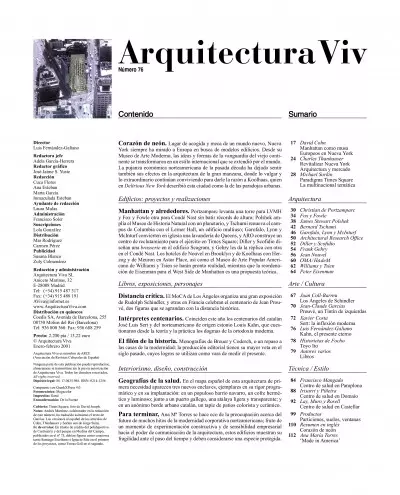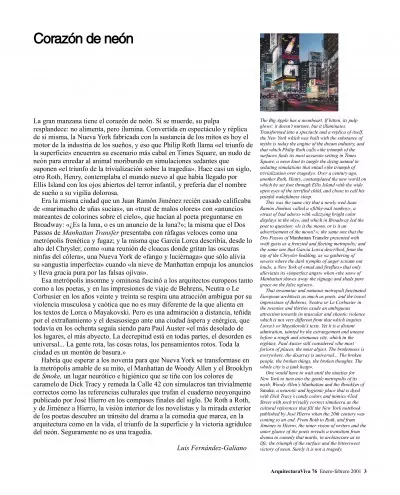Contents
Neonheart. A place of refuge and the Mecca of a new world. New York has always looked towards Europe in search for building models. From the platform of the Museum of Modern Art, the ideas and forms of the old continent’s avant-garde were transformed into an international style that was to spread worldwide. The strong economy of the United States during the past decade has also had its bearing on the architecture of the Big Apple, where the vulgar and the extraordinary still coexist to confirm the views of Rem Koolhaas, who in Delirious New York described this city as that of urban contradictions.
Synopses
David Cohn
Manhattan as Muse
Europeans in New York
Charles Thanhauser
Revitalizing New York
Architecture and the Market
Michael Sorkin
Times Square Paradigm
The Thematic Multinational
Buildings: Projects and Realizations
In and Around Manhattan. Portzamparc raises a tower for LVMH and Fox & Fowle another for Condé Nast without beating height records; Polshek extends the American Museum of Natural History with a planetary, and Tschumi renovates the Columbia campus with the Lerner Hall, a multipurpose building; Garofalo, Lynn and McInturf transform a Queens laundromat into a church, and ARO builds a US Armed Forces Recruiting Center in Times Square; Diller & Scofidio design a brasserie in the Seagram Building, and Gehry does the same in the Condé Nast. The hotels by Nouvel in Brooklyn and by Koolhaas and Herzog & de Meuron in Astor Place, as well as the Museum of American Folk Art by Williams & Tsien will soon materialize, while Eisenman’s reorganization of West Side Manhattan is a theoretical proposal.
Architecture
Christian de Portzamparc
Fox y Fowle
James Stewart Polshek
Bernard Tschumi
Garofalo, Lynn y McInturf
Architectural Research Office
Diller y Scofidio
Frank Gehry
Jean Nouvel
OMA/H&deM
Williams y Tsien
Peter Eisenman
Books, Exhibitions, Personalities
Critical Distance. The Los Angeles MoCA organizes a large exhibition devoted to Rudolph Schindler, and others in France celebrate the centenary of Jean Prouvé, two figures that grow in stature with time. Art / Culture
Juan Coll-Barreu
Los Ángeles de Schindler
Jean-Claude Garcias
Prouvé, un Tintín de izquierdasCentenarian Interpreters. This year is marked by the centenaries of the Catalan José Luis Sert and the Estonian-born American Louis Kahn, who questioned the dogmas of modern orthodoxy in theory and practice. Xavier Costa
Sert: a Modern Turn
Luis Fernández-Galiano
Kahn, the Timeless PresentBenefiting from History. Monographs of Breuer and Coderch, or a review of the houses of modernity: the editorial production has a limitless source in the past century, whose achievments serve to measure the present.
Focho’s Cartoon
Toyo Ito
Various Authors
Books
Interiors, Design, Construction
Geographies of Health. Three new sites have appeared in Spain’s map of basic needs architecture, exemplary in their strict program and insertion: within a populous Navarrese neighborhood, a luminous and hermetic chest; next to a port in Galicia, a light and transparent watchtower; and in an unknown Catalan urban boundary, a ceramic and colorful tapestry of courtyards. Technique / Style
Francisco Mangado
Health Center in Pamplona
Irisarri & Piñera
Health Center in Domaio
Lay, Muro y Rosell
Health Center in CastellarTo close, Ana Mª Torres echoes the present concern for the future of several landmarks of American corporate modernity; product of a period of many innovations in building construction and of a new awareness in business of the communicative power of architecture, these works show now their fragility with the passage of time, and ought to be considered a protected species. Products
Partitions, Floors, Windows
English Summary
Neonheart
Ana María Torres
‘Made in America’
Luis Fernández-Galiano
Neonheart
The Big Apple has a neonheart. If bitten, its pulp glows: it doesn’t nurture, but it illuminates. Transformed into a spectacle and a replica of itself, the New York which was built with the substance of myths is today the engine of the dream industry, and that which Philip Roth calls «the triumph of the surface» finds its most accurate setting in Times Square, a neon knot to tangle the dying animal in sedating simulations that entail «the triumph of trivialization over tragedy». Over a century ago, another Roth, Henry, contemplated the new world on which he set foot through Ellis Island with the wide open eyes of the terrified child, and chose to call his painful wakefulness sleep.
This was the same city that a newly wed Juan Ramón Jiménez called a «filthy-nail tomboy», a «trust of bad odors» with «dizzying bright color displays in the sky», and which in Broadway led the poet to question: «Is it the moon, or is it an advertisement of the moon?»; the same one that the Dos Passos of Manhattan Transfer presented with swift gusts as a frenzied and fleeting metropolis; and the same one that García Lorca described, from the top of the Chrysler building, as «a gathering of sewers where the dark nymphs of anger scream out loud», a New York of «mud and fireflies» that only alleviates its «imperfect angst» when «the snow of Manhattan shoves away the signage and sheds pure grace on the false ogives».
That insomniac and ominous metropoli fascinated European architects as much as poets, and the travel impressions of Behrens, Neutra or Le Corbusier in the twenties and thirties exude an ambiguous attraction towards its muscular and chaotic violence which is not very different from that which inspires Lorca’s or Mayakovski’s texts. Yet it is a distant admiration, tainted by the estrangement and unease before a rough and strenuous city, which in the eighties, Paul Auster still considered «the most forlorn of places, the most abject. The brokenness is everywhere, the disarray is universal... The broken people, the broken things, the broken thoughts. The whole city is a junk heap».
One would have to wait until the nineties for New York to turn into the gentle metropolis of its myth, Woody Allen’s Manhattan and the Brooklyn of Smoke, a neurotic and hygienic place that is dyed with Dick Tracy’s candy colors and mimics 42nd Street with such trivially correct simulacra as the cultural references that fill the New York notebook published by José Hierro when the 20th century was coming to an end. From Roth to Roth, and from Jiménez to Hierro, the inner vision of writers and the outer glance of the poets reveals a transition from drama to comedy that marks, in architecture as in life, the triumph of the surface and the bittersweet victory of neon. Surely it is not a tragedy.








